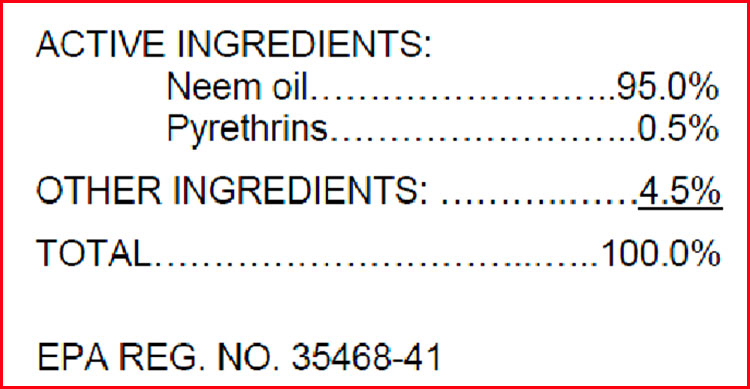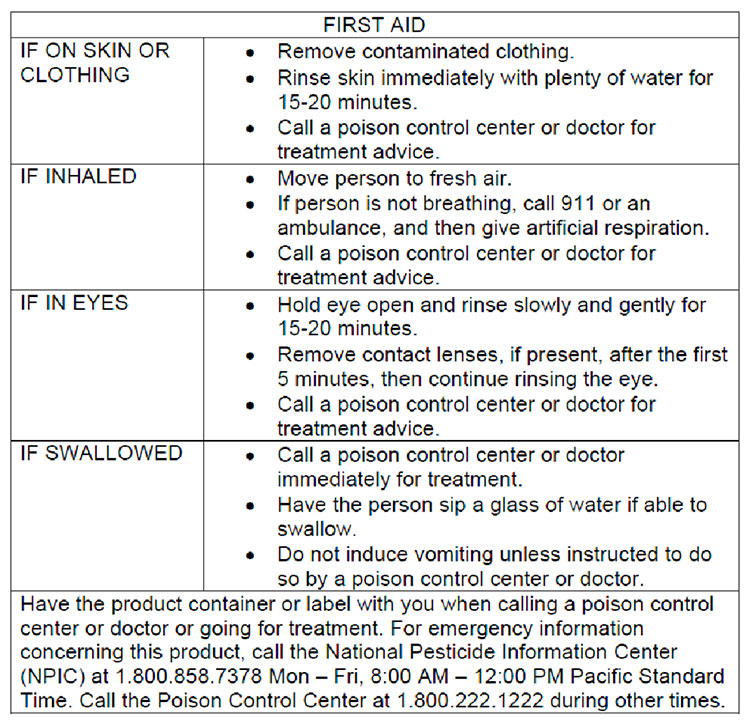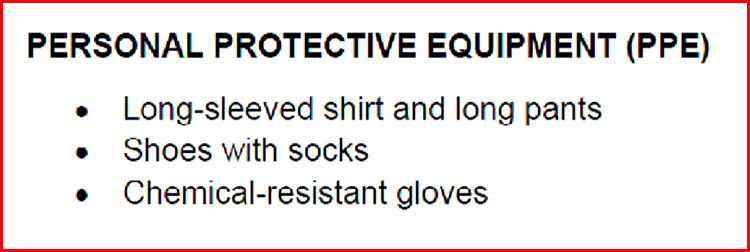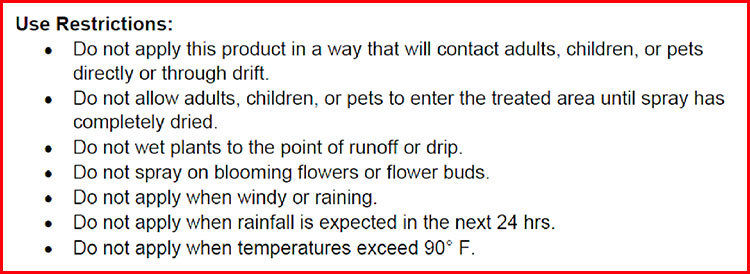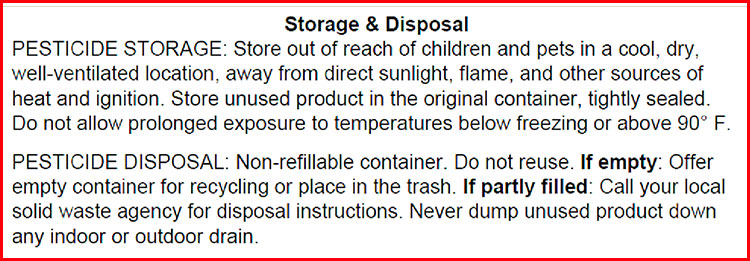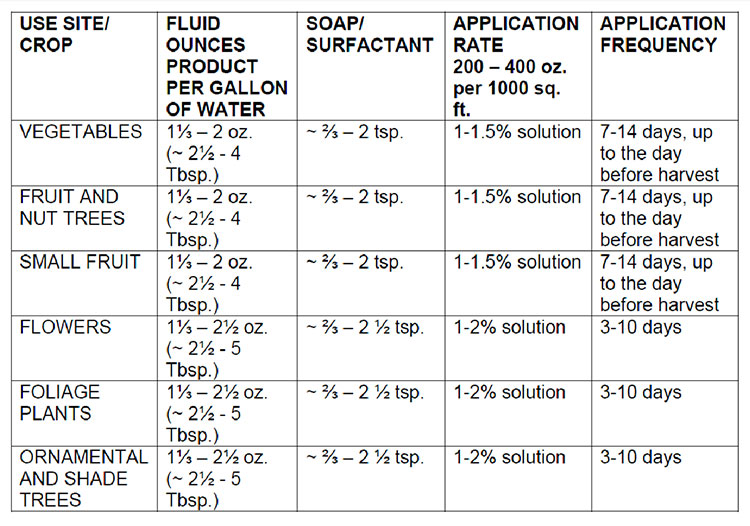Label Interpretation
By Kerry Bernard, Pesticide Safety Education Program Professional, UMaine Extension
Last spring, I visited a relative in southern Maine. There, at her now-suburban farmhouse, in spring, the conversation inevitably turned to ticks. She expressed annoyance that her cat was still picking them up, despite having had the property professionally sprayed. I pointed out that the cat roamed beyond the border spray, and rolled my eyes at the mention of his bargain-bin flea collar.
Then this relative told me she’d sprayed him with “tick spray” to take care of it.
I sat up straight. What “tick spray”? The stuff in the yellow bottle?
You can’t do that.
She admitted she’d sprayed herself too.
And why shouldn’t she? The product sits right there on the shelves for anyone to grab, usually beside the insect repellent that’s meant to be applied to the skin.
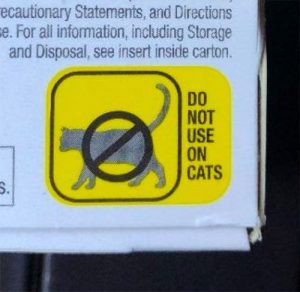
But the stuff in the yellow bottle contains permethrin.
Permethrin is a synthetic version of pyrethrum, an insecticidal extract from chrysanthemums. While low in human toxicity, the EPA has classified it as “likely carcinogenic to humans” with oral exposure.
And cats are extremely sensitive to it. At high concentrations, it can cause neurological symptoms, including seizures, which may lead to death if left untreated.
Thankfully, the low concentration of permethrin in that particular product caused no adverse reaction (in either human or cat) this time around. Still, the product is only for treating clothes (while unworn) and equipment.
Despite her insistence that her first bout with Lyme disease affected her brain, my relative is a smart woman. So how did she make this mistake?
She didn’t read the label.
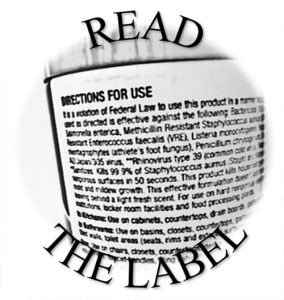
Many people don’t. And most probably don’t realize they have to (consider this notice), or even that the product they’re using is a pesticide. But many products we use around the home are pesticides, including weed and feeds, mosquito repellents, ant baits, swimming pool chemicals, flea collars, mold and mildew control products, rat and mouse baits, disinfectants (including bleach), garden dusts and sprays, and that good old aerosol can of insecticide. It doesn’t matter how “natural” the product purports to be either. Products with an essential oil or microorganism as the active ingredient are still pesticides. And all pesticides require strict adherence to the label. Any assurance of effectiveness or expectation that the use of the product will not cause unreasonable adverse effects to human health or the environment depends upon that adherence.
Unfortunately, labels can be hard to read and harder to interpret. Many are long and technical, and how they present required information varies widely between them. There are, however, components common to most labels, and for individuals who use pesticides, it’s well worth a little practice navigating them.
The top of the label may say a lot or very little about what the product is.
In this case, our make-believe label states the formulation: ‘EC’ for emulsifiable concentrate. This is a common formulation that requires dilution, and usually contains a solvent and surfactant (detergent). Other products might say ‘RTU’ or ‘ready-to-use’, WP or wettable powder, simply ‘concentrate’, ‘granules’, ‘bait’, etc. There are advantages and disadvantages to each. Choosing a ready-to-use product eliminates mixing, which then reduces pesticide exposure and the amount of math required before an application.
Beneath the trade name, most products state the type of pesticide in the container. Botanical tells us that the active pesticide ingredients are derived from plants. Insecticide means it will kill at least some types of insects. Fungal suppressant means the product probably slows or prevents the growth of some fungal plant diseases. Here a product might also state something like ‘For residential use on crops and ornamentals’ or ‘for control of insects in residential gardens’.
The active ingredients are the pesticidal components of a product. They are often listed by both their common (here) and chemical names.
Neem oil, which contains azadirachtin, acts as an insect growth regulator, repellent, and antifeedant. It is extracted from neem seeds. It’s been used for pest control and in hygiene products and traditional medicine in other parts of the world for centuries.
Pyrethrins are the natural pesticides extracted from chrysanthemum flowers. Generally, both neem oil and pyrethrins are low in mammalian toxicity.
The label usually only names inert ingredients if they present a significant additional risk. For instance, some pesticides contain methanol, which can cause blindness, or aromatic hydrocarbons as solvents, which can be very dangerous if aspirated.
Before a pesticide product can hit the shelves, the EPA has to evaluate it thoroughly for safety*. If the product meets EPA standards, it’s granted registration and given a registration number. All of the product’s information is tied to this number.
*Note: Some minimum risk (25(b)) pesticide products are exempt from registration with the EPA, however they still must be registered with the Maine Board of Pesticides Control to be legally sold and used here.
Pesticide products have one of four signal words.
A product’s signal word is an indication of its acute toxicity. It does not reflect the risks of repeated or long-term exposure.
CAUTION: Slightly toxic (Category III), can be harmful. Less hazardous. (It would take ingesting more than 1 oz. of a pesticide with this designation to kill a 150 lb adult)
WARNING: Moderately toxic (Category II). Harmful, possibly fatal. Hazardous. (Ingesting 1 tsp-1 Tbsp can be fatal).
DANGER: Highly toxic (Category I). May be fatal. Corrosive and may cause contact injury to the skin, eyes, or lungs. May cause blindness. Extremely hazardous.
DANGER POISON / PELIGRO with skull and crossbones: Fatal through one or more routes of entry. Systemic injury. Extremely hazardous. (Ingestion of trace amounts – 1 tsp may be fatal to a 150 lb person).
All pesticides must be stored somewhere inaccessible to children, preferably under lock and key.
Each label has a statement of practical treatment.
This one is the standard. Some products may have instructions that are more specific. For instance, organophosphate and carbamate pesticides will have a note at the bottom informing physicians that atropine works as an antidote.
Even though neem oil and pyrethrins are low-risk pesticides, both can still cause harm. Neem oil can irritate the eyes and skin and cause allergic reactions. Azadirachtin, the concentration of which can vary from one batch of neem oil to the next, can cause serious irritation and gastrointestinal symptoms. Pyrethrins can cause skin irritation and tingling, eye irritation, and, reportedly, asthma-like symptoms. At various doses, pyrethrins have caused neurological symptoms, respiratory damage, and developmental effects in laboratory animals.

Personal Protective Equipment (PPE)
This is one of the most important parts of the label. Wear all PPE listed, these are not suggestions. If the label doesn’t specify PPE, wearing long clothes, shoes, socks, and gloves is still a good rule of thumb. Don’t mix or apply pesticides in shorts or open-toed shoes. If it is too hot to wear long clothes safely, wait until the weather cools off. More PPE is often required when mixing than applying pesticides; the label will say what to wear during each stage if there are differences. When in doubt, wear more PPE than directed. More is usually better and less is illegal. Many pesticides require a respirator. Be sure to understand what type to wear for a given product, and how to use a respirator correctly. If unsure how to properly wear a respirator, or if shortages prevent it, consider using a product that doesn’t require one. Some pesticide products require very specific equipment such as gloves of a certain material and/or thickness. Contact the product manufacturer, University of Maine Cooperative Extension, or the Board of Pesticides Control, for help interpreting the label’s instructions regarding PPE, don’t guess. Proper storage and maintenance of reusable PPE is also important. Damaged and/or contaminated equipment does not offer sufficient protection. Follow manufacturer directions, but generally, PPE should be cleaned with soap and water after use (without contaminating anything else in the process), stored in a clean, dry place, out of direct sunlight, and inspected before each use. Double wash clothes or coveralls worn during pesticide use separate from family laundry with warm water and a heavy-duty detergent, then hang them in the sun to dry.
Depending on the product and the active ingredients it contains, the label will bear various environmental warnings.
Highly water-soluble products may bear groundwater advisories. Highly volatile products may warn of drift and spraying in hot, dry weather. Products formulated as granules may warn of the risk to birds.
All pesticide products can have environmental effects. Even though the active ingredients in this product are natural, using it would still come with environmental risk. Neem oil is unlikely to harm mammals, birds, and bees in the environment, but it is mildly toxic to aquatic organisms. Pyrethrins are highly toxic to bees and aquatic organisms, including fish and lobsters. They do usually break down quickly, however.
Unless a pesticide product is designed for treating water, keep it away. Don’t treat around wells, drains, and surface waters, and don’t allow these areas to become contaminated by drift or runoff. Not only can pesticides get into our drinking and recreational waters this way, affecting our health, but many aquatic organisms are extremely sensitive to them. And some pesticides may break down much more slowly in water than they do on land.
Many labels also warn of a product’s danger to bees. Unfortunately, given that they’re insects, bees are affected, if not killed, by most contact insecticides. Some other types of pesticides have adverse effects on bees and other pollinators as well. Avoid treating plants with blooming flowers or flowers nearing bloom. If the product is for treating blooms, try to treat them in the evening, when pollinator activity is winding down.
This section of the label explains how to use the product and how NOT to use it.
They’re not kidding. Pesticide labels are legal documents. THE LABEL IS THE LAW!
The label should display the following information, if applicable:
- Pests controlled.
- Plants/animals/sites protected.
- Necessary equipment.
- Mixing instructions.
- How much to apply.
- How often to apply.
- When to apply, including PHI – preharvest interval (how near to harvest the product can last be applied).
- Where the product can be applied.
- Buffer zones (to protect people, water, other crops or vegetation, etc.).
- Plant-back interval (some crops can’t be planted on a site treated with a certain product for months or even years).
- Compatibility with other pesticides, adjuvants, fertilizers, etc.
- Phytotoxicity (the product’s potential to injure plants).
- Additional restrictions.
Don’t violate any use restrictions. Doing so will put human, animal, and environmental health at risk. It may also render the product less effective or even harm the plants it’s supposed to protect. For example, the last restriction is in place because some chemicals in neem oil can inactivate in the heat, and this product is more likely to have phytotoxic effects in hot weather.
Pesticide storage and disposal instructions may be located here or near the end of the label.
Storage instructions may very slightly but in general:
- Store pesticides above freezing, in a cool, dry, well-ventilated place.
- Store in original, legible container, with the label intact.
- Store herbicides separate from other agrochemicals. If they contaminate other products, when those other products are applied, they may damage the plants.
- Make sure pesticides aren’t accessible to pets, children, or irresponsible adults. They’re best kept locked up. A shed full of pesticides should have not only a lock but a warning sign.
Never reuse a pesticide container. Triple rinse it, puncture it, then recycle/return it or throw it away. Some labels may say the container can be burned or buried, but this is illegal in Maine.
Do NOT dump leftover product—anywhere. Improper disposal of excess pesticide, spray mixture, or rinsate is a violation of Federal law. It’s safer to make extra applications (if label rates allow) to approved sites. Better yet, see if a responsible friend or neighbor needs it. Each October, the Board of Pesticides Control collects banned and unusable pesticide products free of charge in several towns.
Never use a concentrated product without first diluting it. Doing so wastes product, exceeds label application rates, increases the applicator’s pesticide exposure, and may harm the environment or the very plants needing protection. Always follow mixing directions precisely, even if they seem needlessly complicated. Here, if the product was not mixed according to directions, it might disperse unevenly, leaving some plants unprotected, solidify, clog the sprayer, and have phytotoxic (plant-poisoning) effects. To avoid mixing, choose a ready-to-use product.
A pesticide product may only be used on the sites for which it’s labeled. To use it elsewhere is illegal and potentially hazardous. So while this product could be used on garden tomatoes, it could NOT be used on tomatoes in a commercial greenhouse. Neither could it legally and safely be used on wheat, houseplants, lawns, forest trees, artificial structures, pets, or people.
While pesticides can’t be used on unlisted sites and crops, they can be used against unlisted pests. For example, one could legally and safely try using this product on infested fruit trees to control browntail moth (following all laws and use restrictions)—there’s just no assurance it would work. Research has demonstrated that the product can control the listed pests when used properly, no others.
Applying pesticides within rates prescribed by the label is critical for safe and efficient pesticide use.
While legal, applying too little pesticide:
- Won’t control the pest.
- May encourage resistance.
- May require reapplication.
Applying too much pesticide is illegal and:
- May damage plants/property.
- Might harm non-target organisms/the environment.
- May leave harmful residues.
Doing either is a waste of money.
Products labeled for use on food crops will state the preharvest interval (PHI). Here it’s the day before harvest, but it could be as soon as the spray dries, or weeks in advance. Plan ahead.
Notice that the prescribed concentration varies by pest and severity of infestation. The maximum rate allowed also varies by site here. In this case, non-crop plants can be treated more frequently than fruits, vegetables, and nuts. Many products also give a maximum amount of product that can be used per application, and/or per season, in a given area.
Notice the 2% concentration is only for ornamental plants, the maximum concentration for fruits and vegetables is 1.5%. A label may also give different rates within a use site. For instance, potatoes might allow a 1.5% concentration, but lettuce might only allow 1%. Make sure to use the correct rate for the site and plant in question.
This label kindly states exactly how much product and surfactant to add per gallon to achieve appropriate concentrations. Some product labels do not provide this information and it has to be calculated. Instead, they state the rate only as oz. per 1000 sq. ft. or, if the product is also for agricultural use, oz. or lbs. per acre. In either case, the applicator must know the size of the area they intend to treat and the rate at which their application equipment sprays (determined through sprayer calibration).
It helps to have a smartphone/computer or a conversion chart and calculator handy when planning an application.
The label specifies the type of application equipment that should be used and strategies for optimizing control while avoiding harm to the plants.
This section may contain more or less direction, depending on the product, but should be followed closely.
Although labels may contain additional sections (some labels for agricultural products are more than fifty pages long), the parts above provide the critical information that anyone choosing to use a pesticide must be able to interpret. No one should ever pick up a pesticide and start spraying (as my relative did). And no one should apply a pesticide if they don’t fully understand the label. If a label seems unclear, contact the product manufacturer, University of Maine Cooperative Extension, or the Maine Board of Pesticides Control for help with interpretation.
Remember, pesticides are just one pest management tool. In most cases, they should be the last resort.
Sources:
- National Pesticide Information Center
- University of Maine Pesticide Education (CORE) Manual


